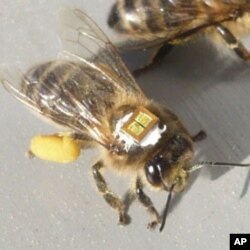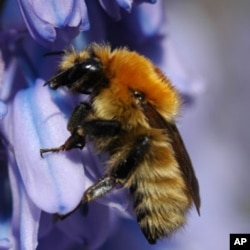A commonly used insecticide disorients bees, making it difficult for them to find their way back to the hive, according to new research.
That may help explain an alarming decline in the numbers of these vital insects seen across the United States and Europe, and the puzzling phenomenon called colony collapse disorder.
A new study, published in Science, shows honeybees exposed to low levels of an insecticide known as a neonicotinoid - which is used by farmers worldwide - left the hive and never returned at about twice the rate of their untreated hivemates.
A second study published in Science saw similar effects on wild bumblebees. Their hives grew more slowly and produced far fewer queens when exposed to a neonicotinoid.
Billion-dollar bees
Bees pollinate the flowers that become fruits, nuts and vegetables. The work these insects do is worth about $18 billion a year to U.S. farmers.
But honeybee colonies in the United States have been shrinking by about a third each year for the past several years.
Colorado beekeeper Tom Theobald says the worst of the die-offs usually happen in the winter.
“If you were a rancher, you’d go out there and you’d have a dead cow. In the case of the bees, there may or may not be a carcass,” he says. “They may have mostly disappeared with just a small remnant [of the hive] left.”
Mysterious disappearance
This mysterious disappearance has been termed colony collapse disorder. Colony collapses account for about a third of the overall loss of honeybees each year, according to the U.S. Department of Agriculture.
No one knows exactly why it happens. A parasite called the varroa mite started attacking honeybee hives in the 1980s.
But Theobald says even as beekeepers started getting the mite problem under control, “The losses not only continued but they escalated. And as we look back, it appears that the reason for that is that the influence of the systemic pesticides was beginning to become more and more dominant.”
Systemic pesticides called neonicotinoids first introduced in the 1990s are now commonly used to coat the seeds of many major crops. The seedlings absorb the chemical as they grow. So, rather than needing to indiscriminately spray a whole field, there is a little bit of insecticide inside each plant.
But that includes the plant's pollen and nectar that the bees are after. It is not enough to kill them. Some studies have show it may be harming them nonetheless. But not all researchers have been convinced.
Intoxicated bees
In one of the new studies, researchers glued tiny microchips to the backs of honeybees. The chips tracked the insects as they came and went from their hive.
The researchers fed the bees sugar water spiked with a low dose of a neonicotinoid and sent them out to forage.
They found these bees were about twice as likely to fail to return as bees not exposed to the insecticide.
Lead author Mickaël Henry from the French national agriculture research institute, INRA, says the bees basically get drunk.
“Intoxicated honeybees with those small doses may just get lost and are unable to find their way back home,” he says.
Wild bees also affected
And it’s not just honeybees that are affected.
Some research has shown bumblebees have a harder time gathering nectar in the laboratory when exposed to neonicotinoids. Bumblebee researcher Dave Goulson at Britain’s University of Sterling and colleagues studied colonies in real-world conditions.
The second study in Science, they found colonies of bees treated with a low dose of a neonicotinoid were smaller than untreated colonies.
Most significantly, Goulson says, “There were 85 percent fewer queens produced when they’d been exposed to realistic field levels of neonicotinoids, which clearly could have very significant implications for bumblebee populations in the wild.”
Only bumblebee queens survive the winter to start new colonies each spring.
That could help explain why bumblebee populations are declining along with the honeybees. And around the world, wild pollinators like bumblebees are more important than honeybees for certain crops.
Overdose
Bayer CropScience, which makes neonicotinoid pesticides, disputes the findings.
“Instead of dosing the animals at field-relevant concentrations as the authors intended," says Bayer spokesman Jack Boyne, "they instead dosed them at levels that are far greater than what would commonly be experienced in the field." Sixty times greater, Boyne says. At that level, he says, it is not surprising that the bees were disoriented.
And he notes that researchers are studying many other factors affecting bee populations, including parasites, diseases, and the stress of transporting commercial beehives.
Purdue University insect scientist Christian Krupke agrees there are a lot of factors threatening bees. But he says the new studies give regulators something to think about.
“Our regulatory system is based on a lethal dose. Is the bee dead, or is it alive? And these studies show that these bees may be alive, but there’s a sublethal dose that’s causing harm to the colony.”
Some European regulators have banned neonicotinoids, and calls for bans in the United States are growing as well.









